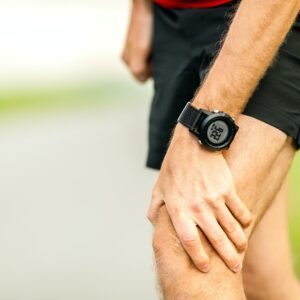Does this sound familiar?
“But I did not do anything to my knee!?”
“It hurts going up and down stairs but down is worse!”
“I have started running more, but that’s it!”
“My doctor says I have patellofemoral pain syndrome, is that serious?”
Many physiotherapists have heard this from patient’s knee pain.

What is Patellofemoral pain syndrome (PFPS)?
Patellofemoral pain syndrome (PFPS) is the most common diagnosis for outpatients with knee pain (Altman et al, 2019; Bolgla et al, 2018; Dixit et al, 2007).
It is caused by imbalances of forces controlling how the kneecap tracks when the knee flexes (bends) and extends (straightens) especially when overloading the joint in activities like running and squatting.
Numerous studies show that it is the most common knee issue in runners and accounts for 16-25% of running injuries according to Dixit et al (2007).
Unfortunately, 70-90% of individuals with PFPS have recurrent or chronic symptoms (Bolgla et al, 2018).
Symptoms
- There is often pain behind, beneath or around the knee cap
- a gradual onset (“It seems to be getting worse the more I run/squat/do stairs”)
- stiffness and pain after prolonged sitting
- snapping/popping
- a feeling of knee giving way (not from joint instability)
- from pain inhibition of the quadriceps and the list goes on (Dixit et all, 2007).
“Due to its multifactorial causes, the treatment of PFPS is complex and involves an intricate interplay of anatomical variations and biomechanical abnormalities.” – (Bolgla et al, 2018).
As it turns out, physiotherapy and a comprehensive rehab program is the mainstay of treatment for PFPS according to the reviewed article by Dixit and colleagues but there is no specific method that wins over the other.
They do state that bracing and taping is no more beneficial.
“The plan of care should include gluteal and quadriceps strengthening exercises, patient education (ie, contributing factors, importance of exercise, rehabilitation expectations), and activity modification.”- (Bolgla et al, 2018)
Here is what that means to me and my patients: It requires an ACTIVE approach!
Yes, tight (and weak) quads are part of it but far too many of my patients with PFPS are telling me they are stretching, resting and getting things done to them (the buzzy stuff and hot packs and/or ice to the knee). The strength discrepancy needs attention, specifically the glutes and the quadriceps, and only consistent resistance exercises will sort that out.
It is also heavily supported to include core and lumbar/trunk muscle strength, movement-retraining, and correction of faulty gait/running patterns (Altman et al, 2019; Bolgla et al, 2018).
The Plan
Here are the initial strengthening (1-5), mobility and stretching (6-8) exercises that I generally issue PFPS sufferers once they have been properly assessed (often issued over 1-3 sessions to ensure proper technique and understanding of the exercises):
- Clamshell with resistance band just above knees 3 x 10-12/side (or until fatigue)
- Glute bridge with knee extension hold band above knees 3 x 10 alternating hold 2-3 sec
- Glute side-step band at midfoot 1-3 x 1,2,3,4,5 reps per direction
- Supine hamstring heel slides 2-3 x 8-10
- Terminal knee extension with resistance band 2-3 x 10-15 reps
- Banded squats to pain free depth 2-3 x 10-15 reps
- Step ups and step downs with good control
- Nordic Curls 3-4 x 6-8 reps
- Front planks with limb movement 2-3 x 10-12 reps
- Side planks with hip abduction 2-3 x 8-10 reps/side
- Paloff press 2-3 x 10-12 reps/side
- ITB, quads and glute foam rolling 2-3 x 30-60 sec per area
- Standing tabletop stretch 2-3 x 30-60 sec
- High knee to wall stretch (aka “Couch Stretch”) 2-3 x 30-60 sec.
For many patients I incorporate dry needling for the quadriceps, ITB, TFL and glutes once they have started the above program. This by no means a “cure all” approach, but it does address the issues that commonly come up in the assessment of PFPS patients. Again, these exercises and techniques are prescribed after a thorough physio assessment.

Another thing that the referenced article (and countless others) and most physios recommend is limiting training volume, especially running/the activity that flares up PFPS. I also propose variance in activities such as rowing, biking, swimming, and other non-impact forms of cardiovascular activity to reduce the overuse effect of only doing one activity constantly.
Finally, I stress with all my patients that these exercises do not end when the pain stops. We never stop having to bring our vehicles in for maintenance… the human body is much the same.
** For further reading, please see reference list below**
References:
Altman R, Beattie P, Ferland A, Herrington L, Kaplan S, Killoran D, McPoil T, Powers C, Torburn L (2019). Patellofemoral Pain: Clinical Practice Guidelines Linked to the International Classification of Functioning, Disability and Health From the Academy of Orthopaedic Physical Therapy of the American Physical Therapy Association. J Ortho Sports Phys Ther49(9): 1-95. Bolgla LA, Boling MC, Mace KL, Fithian DC, Powers CM (2018). National Athletic Trainers’ Association Position Statement: Management of Individuals with Patellofemoral Pain. J of Athletic Training53(9): 820-836. Dixit S, Difiori JP, Burton M, Mines B (2007). Management of Patellofemoral Syndrome.Amer Fam Phys 75(2): 194-202.
